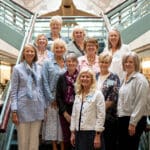A Celebration of 30 Years of the Trinity Mathematics Triathlon
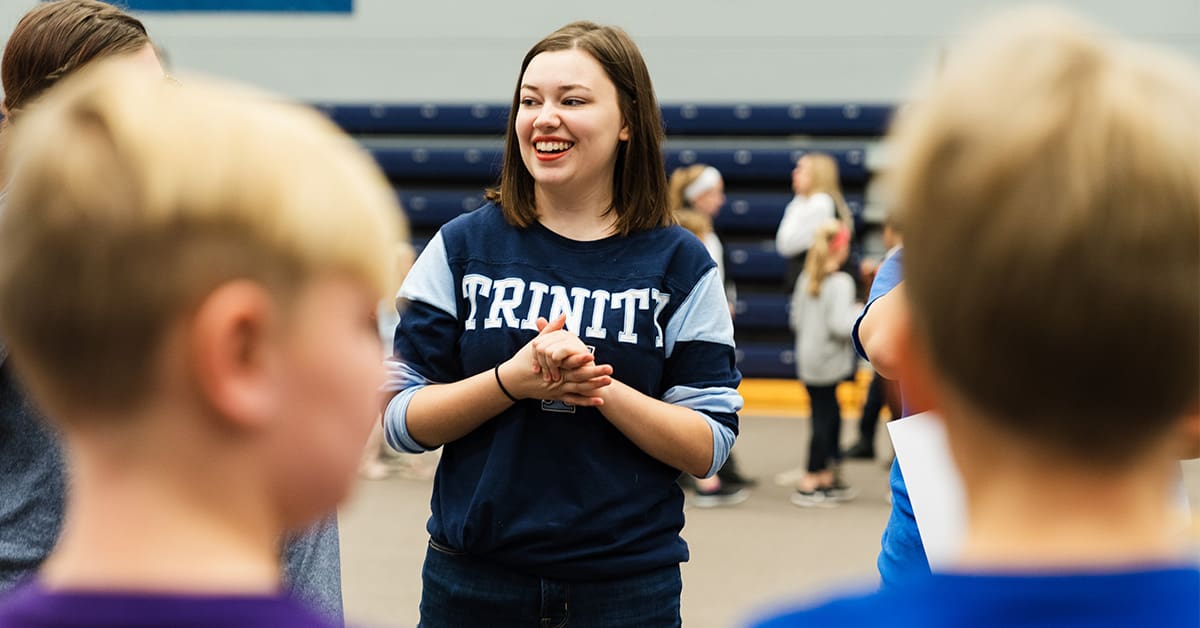
-Liz Rudenga & Dr. Sharon Robbert, Emeritae Professors of Trinity Christian College
Here is a question for you. Which is larger:
30% of 2025 or 2025% of 30?
Before you spend too much time thinking, read about a special event that occurred in April 2025: Trinity hosted 7th and 8th-grade students from private schools for the 30th annual April Trinity Mathematics Triathlon. This year, 187 students from 17 schools in Illinois, Indiana, Michigan, and Wisconsin competed in the three events of the Mathematics Triathlon, bringing the total number of students who participated in a Triathlon event to 9,427.
The Triathlon event was started in 1994 by mathematics professors Dr. Dave Klanderman (1989 – 2019) and Dr. Sharon Robbert (1993 – 2023) with the assistance of adjunct mathematics faculty members Laura Davis (Trinity class of 1990) and Debbie Knot, and the registrar Ron Oosting, who also taught mathematics courses for Trinity. These lovers of mathematics wanted to provide an experience for middle school students that acknowledged their mathematics interest and achievement and kept children excited about learning more mathematics. To achieve this goal, the team decided to distribute lots of prizes to as many children as possible.
The design of that first competition turned out to be a successful formula: three mathematics events (acknowledging Trinity’s name) that promoted different aspects of the way mathematics is done. The first event is an individual test without calculators. The second event is a team test where students collaborate in groups of 3 or 4 to try to solve questions with calculators. And the final event is a 6-minute relay event, where all students from a single school take turns to solve mathematics questions lightning fast. The early year mantra of “the pencil is the baton” gave way to a safer hand tag in later years for the relay event. Trinity students helped to facilitate the events from the start. For all events, the questions are distributed across NCTM Mathematics Content and Process Standards. You can try your hand at the November 2024 Grades 3-6 and April 2025 Grades 7-8 competition events here.
To be able to distribute prizes after the relay event was complete meant that the Triathlon event design had to include some way of entertaining the children while the grading team checked tests and ranked schools. The “half-time” events designed by Dr. Robbert, Dr. Elizabeth DeWitt (2018 – 2025), Prof. Debbie Knot (2022 – present), and Trinity students ranged from events that mimicked popular culture (The Amazing Math Race or Minute to Math It), utilized math-themed games (Qwirkle, Life-size Connect Four) to constructive activities where students built a giant Sierpinski Tetrahedron out of paper Trinity-themed hexaflexagons or a domino design of the Trinity Troll (see images below). Current Trinity math faculty member Prof. Deborah Knot says “I have had the unique privilege of being a cog in the planning of the Triathlon, seeing my own children participate in the Triathlon, being a junior high teacher and sending kids to the Triathlon, and being a mathematics education professor and seeing my students benefit from participating in running the Triathlon. I could not have imagined when this event began the many positive synergies that it would create for the larger Trinity community. It is always good to advance mathematics, but it also fostered community between the Christian schools and gave students an opportunity to celebrate the gifts that God gave them. It has been a great 30 plus years!”
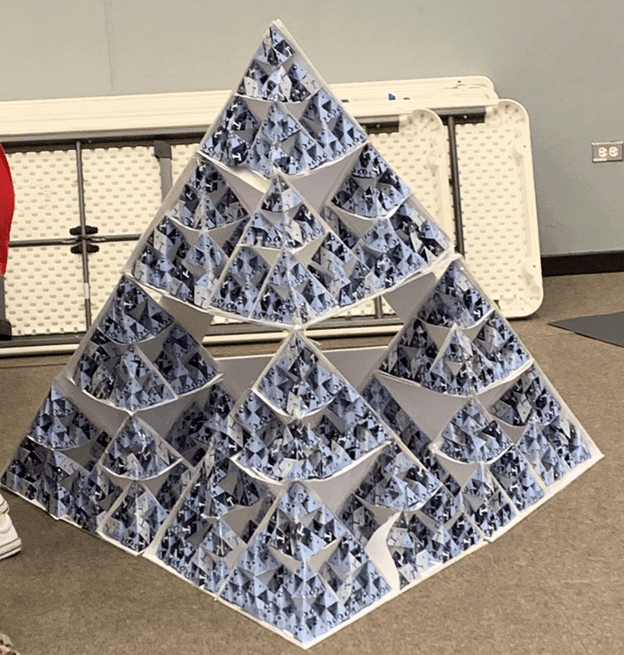
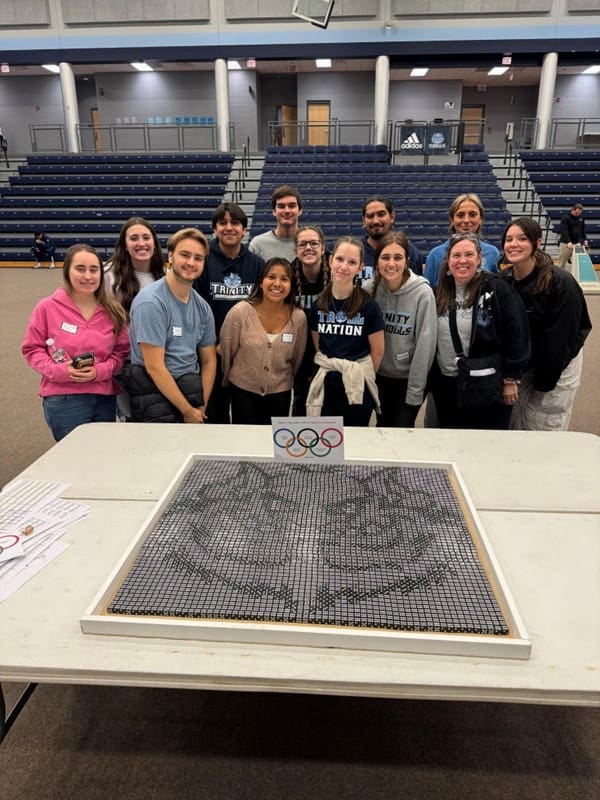
The success of the initial events led to gradual expansions. The best expansion was involving current Trinity students in designing competition materials and games. Other expansions included the design of a Mathematics Triathlon event for children in grades 3-6 in November 2003 (by Dr. Klanderman and Dr. Mary Webster Moore) and seven years of Travelling Mathematics Triathlons from 2002 to 2015, where Trinity math students and faculty travelled to other midwestern states to host events in local schools. Other modifications included an automation of grading records using Microsoft Excel designed by mathematics professor Dr. Mandi Maxwell (2005 – 2019), remote event participation by Skype and Zoom for Trinity alumni who started teaching positions in states far from Illinois (Utah, California, Washington, Pennsylvania, and Florida), and running parallel events in Illinois and Michigan simultaneously. The largest events served more than 300 students in a single day.
One participant in that first 1994 event was Dr. Evan VanderZee, who later earned mathematics and computer science degrees at Trinity (2003) and a Ph.D. in applied mathematics at the University of Illinois at Urbana-Champaign (2010). Dr. VanderZee fondly remembers that first event and his participation as a student assistant during his years as a Trinity student. He says, “Trinity’s math Triathlon and other mathematics competitions that I have participated in over the years have been a fun way to sharpen my problem-solving skills and to share the joy of mathematics with others.”
Another person with multilayered experiences with the Mathematics Triathlon is Trinity alumnae Mrs. Julia Keep (Trinity class of 2011). Mrs. Keep, who has been employed as a Math Triathlon Coordinator from 2019 to the present, participated as a middle school student in 2002, assisted in planning and implementing Triathlon events as a Trinity student, and participated remotely as a teacher with her own students from Pennsylvania and in person with students from Calvin Christian, before joining the planning team. Mrs. Keep says, “Trinity’s Math Triathlon leaves a legacy of rich mathematics and Christian community. Each event has brought people together to have a lot of fun playing with subject matter that I care deeply about. It’s been a blessing to get to experience the Triathlon on so many levels, and I’m forever grateful to the math faculty for building such an impactful event and connecting so many people to it.”
Trinity students—math majors, minors, and future teachers enrolled in math courses—shared in the excitement as they created materials for the event. Dr. Liz Rudenga, who was provost from 2000 to 2014, recalls their thoughtful planning, high energy, and genuine enthusiasm. The event itself brought together a diverse group of students and professors for a meaningful and purposeful experience.
Dr. Dave Klanderman, who now teaches mathematics at Calvin University, has this favorite memory of Trinity Triathlon events. “I especially enjoyed the Traveling Triathlon Interims. Our students did all the design work for the event and performed a variety of roles during each event. My main job was driving the van (and occasionally challenging the students to a game of Scrabble).” Dr. Mandi Maxwell (2005 – 2019), who now teaches mathematics at Taylor University, also has fond memories of Trinity Triathlon events. She says, “Whether it be the January Triathlons in Michigan and Wisconsin, or the annual Math Triathlon events hosted on campus each spring, these opportunities to witness and promote students’ enthusiasm and engagement with math were highlights of my Trinity experience. I loved the balance between the challenge of the individual event, the collaboration of the team event, and the sheer pandemonium of the relay, not to mention the creativity of various ‘halftime’ math activities and the joy of the concluding awards ceremony. Math is meant to be engaged and enjoyed, and the Trinity Math Triathlon enabled so many students to experience just that.” Dr. Sharon Robbert, who retired from teaching mathematics at Trinity in 2023, remembers how difficult it was to balance the desire for including interesting mathematics questions with ones that the children would be able to solve. “We decided that we were successful in the balance if the average number of correct responses hovered between 10 and 12 out of 20 on the individual test and if at least one student solved every problem posed. I’d say we accomplished this about 60% of the time. We just loved those zinger problems to push the students too much.”
Fun facts about the Triathlon:
- The names used in the Triathlon problems are taken from the Trinity students who helped to design the tests.
- Two schools participated in every Triathlon event that Trinity hosted locally: Calvin Christian School (South Holland, IL) and Timothy Christian School (Elmhurst, IL).
- Between 1994 and 2025, in addition to over 1200 student volunteers, ten math, education and computer science Trinity faculty members helped to implement the Trinity Mathematics Triathlon: Dr. Beth DeWitt, Prof. Susan Donovan (Class of 2001), Prof. Christine Henle, Dr. Dave Klanderman, Prof. Debbie Knot, Dr. Mandi Maxwell, Dr. Jeff Nyhoff, Dr. Sharon Robbert, and Dr. Lee VanGroningen (class of 2004), and Dr. Mary Webster Moore.
- The smallest group to participate was a group of four homeschool students in 2016.
- The Trinity Mathematics Triathlon has had at least one event every year since 1994, except during the COVID-19 pandemic. The total number of Trinity Mathematics Triathlon events to date is 66.
- In all the Triathlon events combined, Trinity graders scored more than 23,000 problems on the individual and team events. Every problem is checked twice.
- The number of students who received a perfect score on an individual test is fewer than 10.
- Klanderman and Dr. Robbert know this: “There is no sabbatical break from the Math Triathlon.”
- At least 36 math majors and minors at Trinity were alumni of one or more Trinity Math Triathlons.
- The total number of different Triathlon logos is three.
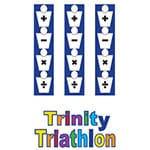
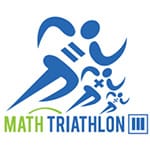
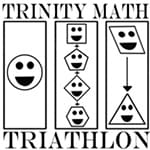
In this story, there are several special numbers:
-
- 2025 is a perfect square (452 = 2025), a product of two squares (52 x 92), a product of three squares (52 x 32 x 32), and the sum of the first 9 cubes (13 + 23 + . . . + 83 + 93).
- Both 1994 and 9487 are the products of two primes: 1994 = 2 x 997 and 9487 = 11 x 857
- 30 is a semiperfect number since 30 = 5 + 10 + 15 and 5, 10, and 15 all divide evenly into 30.
- The number of tetrahedra that make up the 2019 Tetrahedral fractal construction is 1024 = 210. The official name of the figure is a Sierpinski Tetrahedron or a Tetrix.
Many thanks to the many creative colleagues who worked so hard over the years to provide this experience and lifelong memories for so many K-12 students. We celebrate this program and look forward to future iterations of this in the years to come.
The answer: the two values are the same (607.5). Multiplication is commutative.

